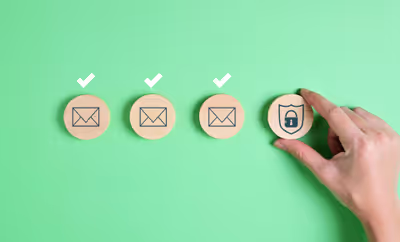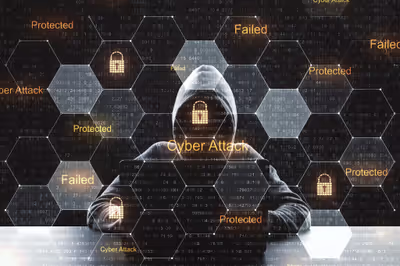· Cybersecurity · 7 min read
Gmail DMARC Requirements 2024: Critical Email Security Update
Google and other major email providers are enforcing strict DMARC, SPF, and DKIM requirements. Learn how to protect your business email deliverability and avoid being marked as spam.

If your business sends emails to customers, partners, or prospects using Gmail, Outlook, or other major email providers, you need to act now. Starting February 2024, Google Gmail and other major email providers are enforcing strict email authentication requirements that could prevent your emails from reaching their intended recipients.
What’s Changing in February 2024?
Google announced that beginning February 1, 2024, all bulk email senders (those sending more than 5,000 emails per day to Gmail recipients) must implement three critical email authentication protocols:
- SPF (Sender Policy Framework)
- DKIM (DomainKeys Identified Mail)
- DMARC (Domain-based Message Authentication, Reporting, and Conformance)
But here’s the critical part: Even if you send fewer than 5,000 emails daily, implementing these protocols is essential for maintaining email deliverability and protecting your brand reputation.
Why This Matters for Every Business
The Email Deliverability Crisis
Without proper authentication:
- Your emails will be marked as spam or rejected entirely
- Customer communications will fail to reach their inbox
- Marketing campaigns will see dramatically reduced open rates
- Important business notifications may never be delivered
The Security Imperative
Email authentication isn’t just about deliverability—it’s about protecting your business and customers from:
- Email spoofing attacks using your domain
- Phishing campaigns that damage your reputation
- Business email compromise (BEC) targeting your organization
- Brand impersonation that erodes customer trust
Understanding the Three Pillars of Email Authentication
SPF (Sender Policy Framework)
SPF allows you to specify which mail servers are authorized to send emails on behalf of your domain.
How it works:
- You publish a DNS record listing approved sending servers
- Receiving servers check if emails come from authorized sources
- Unauthorized emails are rejected or marked as suspicious
Business impact without SPF:
- 67% higher chance of emails being marked as spam
- Increased vulnerability to domain spoofing attacks
DKIM (DomainKeys Identified Mail)
DKIM adds a digital signature to your emails, proving they haven’t been tampered with in transit.
How it works:
- Your email server signs outgoing messages with a private key
- Receiving servers verify the signature using your public key in DNS
- Modified or forged emails fail verification
Business impact without DKIM:
- 45% reduction in email deliverability rates
- Higher risk of email content manipulation
DMARC (Domain-based Message Authentication, Reporting, and Conformance)
DMARC builds on SPF and DKIM, providing policy instructions for handling authentication failures.
How it works:
- You set policies for what to do with emails that fail SPF/DKIM checks
- Options include monitoring, quarantine, or rejection
- You receive detailed reports on email authentication attempts
Business impact without DMARC:
- No visibility into email authentication failures
- Inability to prevent domain abuse
- 73% of phishing attacks use spoofed domains without DMARC
The Real-World Impact: What Businesses Are Experiencing
Case Study: Manufacturing Company
Before Implementation:
- 23% of customer emails marked as spam
- 3 phishing incidents using spoofed company domain
- Customer complaints about missed notifications
After DMARC/SPF/DKIM Implementation:
- 98% email deliverability rate
- Zero successful domain spoofing attempts
- 40% increase in email engagement rates
Industry Statistics:
- 91% of cyberattacks begin with a phishing email
- Businesses with DMARC see 10% higher email open rates
- Organizations without email authentication experience 3x more email-based security incidents
Implementation Timeline: What You Need to Do Now
Phase 1: Immediate Actions (Week 1-2)
1. Audit Your Current Email Setup
- Identify all systems sending emails from your domain
- Document current SPF and DKIM configurations
- Check existing DMARC policy (if any)
2. Implement Basic SPF Record
Create a DNS TXT record for your domain with an SPF policy:
Record Type: TXT Name: @ (or your domain name) Value: v=spf1 include:_spf.google.com include:mailgun.org ~all
What each part means:
v=spf1- SPF version 1include:_spf.google.com- Allow Google servers to sendinclude:mailgun.org- Allow Mailgun servers to send~all- Soft fail for unauthorized servers
Important: Customize for your email providers. Common includes:
- Google Workspace:
include:_spf.google.com - Microsoft 365:
include:spf.protection.outlook.com - Mailchimp:
include:servers.mcsv.net - SendGrid:
include:sendgrid.net
3. Set Up DKIM Signing
- Configure DKIM in your email service provider settings
- Generate DKIM keys in your email platform
- Publish the DKIM public key as a DNS TXT record
Phase 2: DMARC Deployment (Week 2-4)
1. Start with Monitoring Policy
Begin with a monitoring-only DMARC policy to collect data without affecting email delivery:
Record Type: TXT Name: _dmarc Value: v=DMARC1; p=none; rua=mailto:dmarc-reports@yourdomain.com
2. Gradual Enforcement
What this means:
v=DMARC1- DMARC version 1p=none- Monitor only, don’t take action on failuresrua=mailto:...- Send aggregate reports to this email address
2. Analyze DMARC Reports
- Monitor reports for 1-2 weeks to understand your email traffic
- Identify legitimate vs. unauthorized email sources
- Fine-tune SPF and DKIM configurations based on findings
- Look for authentication failures that need addressing
3. Gradually Enforce Policies
After monitoring shows good authentication rates, progressively tighten policies:
Step 1 - Quarantine Policy:
Set up a gradual enforcement policy to test with a small percentage of emails:
Record Type: TXT Name: _dmarc Value: v=DMARC1; p=quarantine; pct=10; rua=mailto:dmarc-reports@yourdomain.com
3. Full Protection
This policy means:
p=quarantine- Move suspicious emails to spam folderpct=10- Apply policy to only 10% of emails initiallyrua=mailto:...- Send reports to monitor results
Step 2 - Full Enforcement:
Once you’re confident in your authentication setup, implement full protection:
Record Type: TXT Name: _dmarc Value: v=DMARC1; p=reject; rua=mailto:dmarc-reports@yourdomain.com
This policy means:
p=reject- Block all emails that fail authentication- No
pctparameter means 100% enforcement - Continue receiving reports to monitor effectiveness
Phase 3: Ongoing Monitoring (Ongoing)
1. Weekly DMARC Report Analysis
- Review authentication pass/fail rates
- Investigate any new unauthorized sending sources
- Monitor for changes in email volume or patterns
2. Quarterly Authentication Audits
- Test email delivery across major providers
- Verify all business email systems are properly authenticated
- Update configurations as email infrastructure changes
3. Continuous Optimization
- Adjust policies based on business needs and threat landscape
- Keep DNS records updated as email services change
- Train team members on email security best practices
Common Implementation Challenges and Solutions
Challenge: Multiple Email Sending Services
Problem: Many businesses use various platforms (CRM, marketing automation, transactional email services) that all send from the same domain.
Solution:
- Create comprehensive SPF record including all services
- Implement DKIM for each sending service
- Use subdomain delegation for complex setups
Challenge: Third-Party Email Services
Problem: Marketing platforms, customer support tools, and other services send emails on your behalf.
Solution:
- Work with vendors to ensure proper authentication setup
- Use dedicated subdomains for third-party services
- Implement strict DMARC policies for your primary domain
Challenge: Legacy Email Systems
Problem: Older email servers may not support modern authentication methods.
Solution:
- Upgrade to modern email infrastructure
- Use cloud-based email services with built-in authentication
- Implement gradual migration strategy
Industry-Specific Considerations
Healthcare Organizations
- HIPAA compliance requires secure email communications
- Patient notification emails must reach recipients reliably
- Protected health information needs additional security layers
Financial Services
- Regulatory requirements mandate secure communications
- Fraud prevention relies on email authentication
- Customer trust depends on preventing impersonation
E-commerce Businesses
- Order confirmations and shipping notifications must be delivered
- Marketing campaigns require high deliverability rates
- Customer service communications need reliable delivery
Educational Institutions
- Student and parent communications are mission-critical
- Administrative notices must reach recipients
- Fundraising campaigns depend on email deliverability
The Cost of Inaction
Immediate Consequences (February 2024 onwards):
- Emails rejected by Gmail, Outlook, and other providers
- Marketing campaigns fail with dramatically reduced reach
- Customer communications disrupted affecting service quality
- Revenue loss from failed transactional emails
Long-term Impact:
- Damaged sender reputation difficult to recover
- Increased cybersecurity risk from domain spoofing
- Customer trust erosion from failed communications
- Competitive disadvantage as others implement proper authentication
Getting Professional Help: Why Expertise Matters
Email authentication implementation involves:
- Complex DNS configurations that can break email if done incorrectly
- Multi-vendor coordination across email services and platforms
- Gradual policy enforcement to avoid disrupting legitimate emails
- Ongoing monitoring and optimization for maximum effectiveness
What Professional Implementation Includes:
- Comprehensive email audit of all sending sources
- Custom authentication strategy for your business needs
- Phased implementation plan minimizing disruption
- DMARC report analysis and optimization
- Ongoing monitoring and support
- Employee training on email security best practices
Take Action Now: Your Email Deliverability Depends on It
The February 2024 deadline isn’t a suggestion—it’s a hard requirement from the world’s largest email providers. Businesses that don’t implement proper email authentication will see immediate impacts on their ability to communicate with customers, partners, and prospects.
Next Steps:
- Assess your current email authentication status
- Identify all systems sending emails from your domain
- Create an implementation timeline
- Test configurations thoroughly before enforcement
- Monitor and optimize ongoing performance
Don’t let this critical deadline catch your business unprepared. The time to act is now, before your emails start bouncing and your business communications are disrupted.
Need help implementing DMARC, SPF, and DKIM before the February deadline? Northshire Tech specializes in email security and authentication for businesses of all sizes. Contact us today for a comprehensive email security assessment and implementation plan that protects your deliverability and secures your domain.




